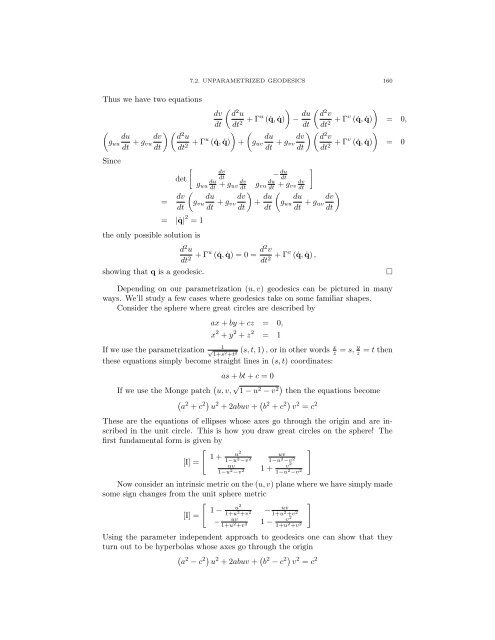Lecture Notes for 120 - UCLA Department of Mathematics
Lecture Notes for 120 - UCLA Department of Mathematics
Lecture Notes for 120 - UCLA Department of Mathematics
You also want an ePaper? Increase the reach of your titles
YUMPU automatically turns print PDFs into web optimized ePapers that Google loves.
7.2. UNPARAMETRIZED GEODESICS 160<br />
Thus we have two equations<br />
✓<br />
du<br />
g uu<br />
dt + g vu<br />
Since<br />
dv<br />
dt<br />
◆✓ d 2 u<br />
dt 2 +<br />
apple<br />
det<br />
✓<br />
dv d 2 u<br />
dt dt 2 +<br />
◆<br />
u ( ˙q, ˙q)<br />
g uu<br />
du<br />
dv<br />
dt<br />
= dv ✓<br />
du<br />
g vu<br />
dt dt + g vv<br />
= | ˙q| 2 =1<br />
the only possible solution is<br />
d 2 u<br />
dt 2 +<br />
showing that q is a geodesic.<br />
+<br />
dt + g uv dv<br />
dt<br />
dv<br />
dt<br />
◆<br />
u ( ˙q, ˙q)<br />
✓<br />
g uv<br />
du<br />
dt + g vv<br />
g vu<br />
du<br />
◆<br />
+ du<br />
dt<br />
du<br />
dt<br />
✓ du d 2 v<br />
dt dt 2 +<br />
◆✓ d 2 v<br />
dt 2 +<br />
dv<br />
dt<br />
dt + g vv dv<br />
dt<br />
✓<br />
du<br />
g uu<br />
dt + g uv<br />
u ( ˙q, ˙q) =0= d2 v<br />
dt 2 + v ( ˙q, ˙q) ,<br />
◆<br />
dv<br />
dt<br />
◆<br />
v ( ˙q, ˙q)<br />
◆<br />
v ( ˙q, ˙q)<br />
= 0,<br />
= 0<br />
⇤<br />
Depending on our parametrization (u, v) geodesics can be pictured in many<br />
ways. We’ll study a few cases where geodesics take on some familiar shapes.<br />
Consider the sphere where great circles are described by<br />
ax + by + cz = 0,<br />
x 2 + y 2 + z 2 = 1<br />
If we use the parametrization<br />
1 p<br />
1+s2 +t 2 (s, t, 1) , or in other words x z = s, y z = t then<br />
these equations simply become straight lines in (s, t) coordinates:<br />
as + bt + c =0<br />
If we use the Monge patch u, v, p 1 u 2 v 2 then the equations become<br />
a 2 + c 2 u 2 +2abuv + b 2 + c 2 v 2 = c 2<br />
These are the equations <strong>of</strong> ellipses whose axes go through the origin and are inscribed<br />
in the unit circle. This is how you draw great circles on the sphere! The<br />
first fundamental <strong>for</strong>m is given by<br />
"<br />
u<br />
1+ 2<br />
[I] =<br />
#<br />
uv<br />
1 u 2 v 2 1 u 2 v 2<br />
1 u 2 v 2<br />
uv<br />
v<br />
1 u 2 v<br />
1+ 2<br />
2<br />
Now consider an intrinsic metric on the (u, v) plane where we have simply made<br />
some sign changes from the unit sphere metric<br />
"<br />
[I] =<br />
#<br />
u<br />
1 2<br />
uv<br />
1+u 2 +v 2 1+u 2 +v 2<br />
uv<br />
v<br />
1+u 2 +v<br />
1 2<br />
2 1+u 2 +v 2<br />
Using the parameter independent approach to geodesics one can show that they<br />
turn out to be hyperbolas whose axes go through the origin<br />
a 2 c 2 u 2 +2abuv + b 2 c 2 v 2 = c 2
















